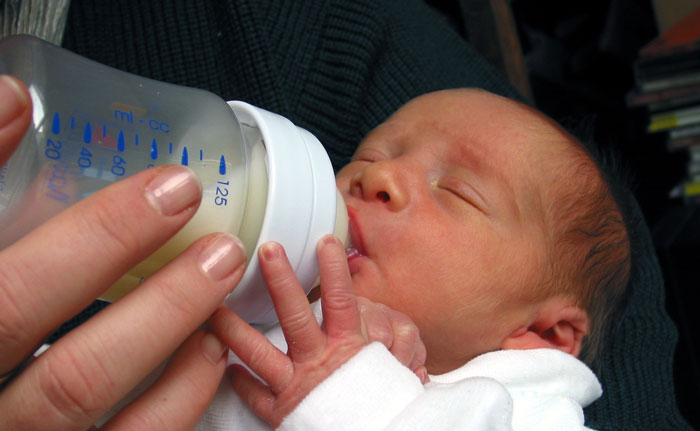Nutrition and preterm infants
- Like
- Digg
- Del
- Tumblr
- VKontakte
- Buffer
- Love This
- Odnoklassniki
- Meneame
- Blogger
- Amazon
- Yahoo Mail
- Gmail
- AOL
- Newsvine
- HackerNews
- Evernote
- MySpace
- Mail.ru
- Viadeo
- Line
- Comments
- Yummly
- SMS
- Viber
- Telegram
- Subscribe
- Skype
- Facebook Messenger
- Kakao
- LiveJournal
- Yammer
- Edgar
- Fintel
- Mix
- Instapaper
- Copy Link
Posted: 20 August 2021 | Dr Melinda Elliott | No comments yet
Human milk-based fortifiers in hospital NICUs are revolutionary, but are they all the same? Dr Melinda Elliott elucidates the issues.


The American Academy of Pediatrics recommends that infants be fed exclusively with breastmilk during the first six months of life due to evidence of both short- and long-term medical and neurodevelopmental advantages.1 This recommendation applies to all infants but may be particularly important for preterm (premature) infants, who are known to be at higher risk of morbidity and mortality,2,3 including neurodevelopmental impairment.4
The challenge in the neonatal intensive care unit (NICU) is to provide the intensive nutrition offered by the placenta in utero for preterm infants. The third trimester of pregnancy is a period of exponential growth, particularly of the lungs and brain.5 This means that preterm infants cannot be fed with breastmilk alone. They require fortifiers added to the breastmilk to provide the intensive nutrition needed to support healthy growth.1
A closer look at human milk-based fortifiers
Just as baby formula has traditionally been made from cow’s milk, so too have nutritional fortifiers used in the NICU. Unfortunately, cow’s milk-based fortifiers have been associated with an increased risk of serious, life-threatening complications, which has necessitated the adoption of delayed or very slowly advancing feeding schedules, essentially decreasing nutritional intake in an attempt to reduce morbidity and mortality.6,7
Today, nutritional fortifiers designed for preterm infants that are made exclusively from human milk represent an evidence-based standard of care. Prolacta Bioscience (Duarte, CA) has been a pioneer in this space, shipping the first ever 100 percent human milk fortifiers to NICUs in 2007. More recently, other manufacturers have begun to enter this arena.
Questions remain, however, as to whether all manufacturers of human milk-based fortifiers are offering products of equivalent nutritional composition, standardisation and safety. In particular, issues surrounding safety, standardisation of components and maintenance of bioactivity have arisen, as the US Food and Drug Administration (FDA) has yet to implement the kind of comprehensive regulations for human milk that it has for other human tissue, such as blood and blood products.
To date, many studies investigating the use of human milk-based fortifiers over cow’s milk-based fortifiers show positive health outcomes. An exclusive human milk-based diet that includes Prolacta’s human milk-based fortifiers (Prolacta’s EHMD) has been linked with improved growth parameters8 as well as reductions of the complications of biggest concern among preterm infants being treated in the NICU: retinopathy of prematurity,9-11 necrotising enterocolitis (NEC),9,10,12 bronchopulmonary dysplasia,10,13,14,15 and late-onset sepsis.9,11,13 Prolacta’s EHMD is also associated with shorter NICU stays10 and reduced hospital costs.10,16
As new companies make human milk-based fortifiers available, it is important to recognise that not all fortifiers are made equally. One reason for this is that not all breastmilk is made equally. The nutritional components of human milk vary depending on factors that include stage of lactation, maternal diet, maternal body stores of certain nutrients, collection method, and even time of day when the milk was collected.17 To produce a fortifier that consistently and reliably offers the same level of nutrition, Prolacta uses more than 20 tests when examining the milk from each individual donor for overall quality and safety, adulteration, Bacillus cereus, nicotine, drugs of abuse, as well as other disease-causing pathogens and bacteria.
Components of human milk
Human milk is primarily made up of protein, fat and carbohydrates. Proteins are essential for growth, neurodevelopment, and immune response in premature infants. Among the proteins found in human milk are immunoglobulins, lactoferrin and lysozyme. These provide protection against infectious agents such as bacteria and viruses and promote immune function.18-23
Fats found in human milk include arachidonic acid (ARA), which supports growth, brain development, immunity and immune response,24 and docosahexaenoic acid (DHA), which supports development of the myelin sheath, brain cell membranes and retinal photoreceptors.25 Also found in human milk are linoleic acid (LA) and α-linolenic acid (α-LA), essential fatty acids that are precursors of ARA and DHA and are necessary for maturation of multiple organ systems, growth and regulation of inflammation.26,27 In addition, the human milk fat globule (MFG) provides rapid availability of energy, influences lipid metabolism and absorption rates, and contains both DHA and ARA.28,29 Finally, the milk fat globule membrane (MFGM) supports structural and functional maturation of the infant gastrointestinal tract. It also modulates the gut microbiota and antimicrobial, anti-inflammatory and prebiotic functions, and supports cognitive development.22,28-30
Carbohydrates found in human milk include human milk oligosaccharides (HMOs). These have a prebiotic function, meaning they support commensal bacteria, and have antimicrobial and anti-inflammatory activity. Low diversity of HMOs and low levels of certain HMOs may predispose an infant to NEC31 compared to a diet with a wide spectrum of HMOs. HMOs may also modulate immune response and support brain development and cognition.32
Processing of human milk: maintaining maximum bioactivity
A crucial step in providing high-quality human milk-based nutritional fortifiers is to employ processing methods that safely eliminate or inactivate pathogens. Unfortunately, while many processing methods achieve this, they also reduce or eliminate the bioactivity of the nutritional components of human milk. For example, the function of proteins depends on their structure and the structure of proteins found in human milk are sensitive to both heat and pressure.33,34 Damage to antibodies, such as immunoglobulin A (IgA), due to high temperature and pressure, creates loss of shape, removing their ability to recognise and bind to antigens – the protective feature antibodies typically provide.35 

Studies suggest that some milk proteins are particularly resistant to proteolysis in the infant gastrointestinal tract, which may reflect the importance of these proteins remaining intact for non-nutritional bioactive function. By remaining intact, secretory immunoglobulin A (sIgA) can, for example, aid development of the infant immune system and protect against infection.36 Prolacta addresses this issue by using a lower temperature pasteurisation method that retains bioactivity while still ensuring a safe product.
Homogenisation and heating of human milk cause structural and compositional changes to the MFGM and may play an important role in the decrease of MFGM bioactivity.37 Heat treatment of human milk (Holder pasteurisation; high-temperature, short-time (HTST); ultrahigh temperature (UHT); and retort sterilisation) appears to have a variable effect on the individual and total MFGM ganglioside content, depending on the processing method. However, homogenisation alters the MFGM structure and likely makes the gangliosides more vulnerable to such heating, which may result in reduced biological activity needed in gut health.38
To maintain the bioactivity of human milk while simultaneously ensuring a safe product, Prolacta employs vat pasteurisation – a process similar to Holder pasteurisation. A study compared the macronutrient (protein, carbohydrate, fat), immune-protective protein, and HMO content of human milk from three independent milk banks that use pasteurisation (Holder and vat techniques) versus retort sterilisation. The study found the concentrations of protein and fat were significantly less in the retort sterilised samples, compared with the Holder and vat pasteurised samples. Concentrations of IgA, immunoglobulin G, immunoglobulin M, lactoferrin, lysozyme, α-lactalbumin, casein, osteopontin, and α-1-antitrypsin proteins were significantly lower in the retort sterilised samples, compared with vat and/or Holder pasteurised samples. In addition, total HMO concentrations with vat pasteurisation were similar to the unprocessed human milk reference, but the concentration of the HMOs containing fucose, sialic acid and nonfucosylated neutral sugars were significantly lower in retort sterilised samples, compared with vat and Holder pasteurised samples.39
Another area in which Prolacta has shown leadership and innovation is in the lengths it takes to ensure safe products. Mass collection and distribution of human milk is a relatively new practice, and thus regulation, at the federal and state level, remains uneven, lagging far behind regulation relating to other human tissue, including blood. Prolacta has always maintained practices that meet or exceed FDA mandates. This includes directly testing milk with a nucleic acid amplification test (NAAT) to detect the presence of infectious disease-causing pathogens in donated breastmilk, such as HIV types 1 and 2, hepatitis B and C, human T-lymphotropic virus type I and type II, Zika virus, Treponema pallidum, and mycobacterium tuberculosis. Prolacta also directly tests milk for traces of drugs, including opiates, nicotine and marijuana, as well as adulterants.
Given the clinically demonstrated role of human milk-based nutrition for vulnerable infants in the NICU, it is imperative to ensure the safety and consistent nutritional quality of fortifiers made from human milk. This means mandating specific data demonstrating standardised nutritional components, preserved bioactivity, and freedom from pathogens and adulterants. In the absence of such data, no assurances about quality and safety can be assumed.
About the author
Dr Melinda Elliott is chief medical officer of Prolacta Bioscience where she serves as the voice of the patient, working to ensure that the needs of critically ill and premature infants are being articulated and that the relevant treatment and product opportunities are identified. As an experienced neonatologist and researcher in neonatal intensive care, Melinda has committed her career to the care of vulnerable, premature infants and has researched the benefits of an EHMD for extremely low birth weight premature infants in the NICU.
References
- Breastfeeding SO. Breastfeeding and the Use of Human Milk. Pediatrics. 2012;129(3):e827-e841. doi:10.1542/peds.2011-3552
- Glass HC, Costarino AT, Stayer SA, Brett CM, Cladis F, Davis PJ. Outcomes for extremely premature infants. Anesth Analg. 2015;120(6):1337-1351. doi:10.1213/ANE.0000000000000705
- Manuck TA, Rice MM, Bailit JL, et al. Preterm neonatal morbidity and mortality by gestational age: a contemporary cohort. Am J Obstet Gynecol. 2016;215(1):103.e1-103.e14. doi:10.1016/j.ajog.2016.01.004
- Adams-Chapman I, Heyne RJ, Demauro SB, et al. Neurodevelopmental impairment among extremely preterm infants in the Neonatal Research Network. Pediatrics. 2018;141(5):e20173091. doi:10.1542/peds.2017-3091
- Koletzko B, Poindexter B, Uauy R, eds. Nutritional care of preterm infants: scientific basis and practical guidelines. World Rev Nutr Diet. Basel, Karger;2014; vol 110:304-305.
- Paul S, Kirkham E, Hawton K, Mannix P. Feeding growth restricted premature neonates: a challenging perspective. Sudan J Paed. Published online 2018:5-14. doi:10.24911/SJP.106-1519511375
- Corvaglia L, Fantini MP, Aceti A, et al. Predictors of full enteral feeding achievement in very low birth weight infants. PLoS One. 2014;9(3):e92235. doi:10.1371/journal.pone.0092235
- Bergner EM, Shypailo R, Visuthranukul C, et al. Growth, body composition, and neurodevelopmental outcomes at 2 years among preterm infants fed an exclusive human milk diet in the neonatal intensive care unit: a pilot study. Breastfeed Med. 2020;15(5):304-311. doi:10.1089/bfm.2019.0210
- Hair AB, Peluso AM, Hawthorne KM, et al. Beyond necrotizing enterocolitis prevention: improving outcomes with an exclusive human milk–based diet. Breastfeed Med. 2016;11(2):70-74. doi:10.1089/bfm.2015.0134
- Assad M, Elliott MJ, Abraham JH. Decreased cost and improved feeding tolerance in VLBW infants fed an exclusive human milk diet. J Perinatol. 2016;36(3):216-220. doi:10.1038/jp.2015.168
- O’Connor DL, Kiss A, Tomlinson C, et al. Nutrient enrichment of human milk with human and bovine milk–based fortifiers for infants born weighing <1250 g: a randomized clinical trial. Am J Clin Nutr. 2018;108(1):108-116. doi:10.1093/ajcn/nqy067
- Sullivan S, Schanler RJ, Kim JH, et al. An exclusively human milk-based diet is associated with a lower rate of necrotizing enterocolitis than a diet of human milk and bovine milk-based products. J Pediatr. 2010;156(4):562-567.e1. doi:10.1016/j.jpeds.2009.10.040
- Delaney Manthe E, Perks PH, Swanson JR. Team-based implementation of an exclusive human milk diet: Adv Neonatal Care. 2019;19(6):460-467. doi:10.1097/ANC.0000000000000676
- Huston R, Lee M, Rider E, et al. Early fortification of enteral feedings for infants <1250 grams birth weight receiving a human milk diet including human milk based fortifier. NPM. 2020;13(2):215-221. doi:10.3233/NPM-190300
- Hair AB, Bergner EM, Lee ML, et al. Premature infants 750–1,250 g birth weight supplemented with a novel human milk-derived cream are discharged sooner. Breastfeed Med. 2016;11(3):133-137. doi:10.1089/bfm.2015.0166
- Ganapathy V, Hay JW, Kim JH. Costs of necrotizing enterocolitis and cost-effectiveness of exclusively human milk-based products in feeding extremely premature infants. Breastfeed Med. 2012;7(1):29-37. doi:10.1089/bfm.2011.0002
- Ballard O, Morrow AL. Human Milk Composition: Nutrients and Bioactive Factors. Pediatr Clin North Am. 2013;60(1):49-74. doi:10.1016/j.pcl.2012.10.002
- Breedveld A, van Egmond M. IgA and FcαRI: pathological roles and therapeutic opportunities. Front Immunol. 2019;10:553. doi:10.3389/fimmu.2019.00553
- Manzoni P. Clinical studies of lactoferrin in neonates and infants: an update. Breastfeed Med. 2019;14(Suppl 1):S25-S27. doi:10.1089/bfm.2019.0033
- Kell DB, Heyden EL, Pretorius E. The biology of lactoferrin, an iron-binding protein that can help defend against viruses and bacteria. Front Immunol. 2020;11:1221. doi:10.3389/fimmu.2020.01221
- Actor JK, Hwang SA, Kruzel ML. Lactoferrin as a natural immune modulator. Curr Pharm Des. 2009;15(17):1956-1973. doi:10.2174/138161209788453202
- Lönnerdal B. Bioactive proteins in human milk—potential benefits for preterm infants. Clin Perinatol. 2017;44(1):179-191. doi:10.1016/j.clp.2016.11.013
- Peila C, Moro GE, Bertino E, et al. The effect of holder pasteurization on nutrients and biologically-active components in donor human milk: a review. Nutrients. 2016;8(8):477. doi:10.3390/nu8080477
- Hadley KB, Ryan AS, Forsyth S, Gautier S, Salem N Jr. The essentiality of arachidonic acid in infant development. Nutrients. 2016;8(4):216. doi:10.3390/nu8040216
- Bzikowska-Jura A, Czerwonogrodzka-Senczyna A, Jasińska-Melon E, et al. The concentration of omega-3 fatty acids in human milk is related to their habitual but not current intake. Nutrients. 2019;11(7):1585. doi:10.3390/nu11071585
- Gleason CA, Juul SE, eds. Avery’s diseases of the newborn. 10th ed. Elsevier:Philadelphia, PA;2018:1009-1022.e4.
- Fleig LN, Unger JP, Cluette-Brown JE, et al. Longitudinal fatty acid levels in preterm infants fed mother’s own milk fortified with human milk-based fortifier versus bovine fortifier. Poster presentation. Session number 4115.285.
- Lee H, Padhi E, Hasegawa Y, et al. Compositional dynamics of the milk fat globule and its role in infant development. Front Pediatr. 2018;6:313. doi:10.3389/fped.2018.00313
- Weiser MJ, Butt CM, Mohajeri MH. Docosahexaenoic acid and cognition throughout the lifespan. 2016;8(2):99. doi:10.3390/nu8020099
- Gallier S, Rowan A. Breastmilk composition and brain development. White paper. Accessed January 8, 2021. https://myaccount.nzmp.com/sfc/servlet.shepherd/version/download/ 0682s000001RSPOAA4
- Wejryd E, Marti M, Marchini G, et al. Low diversity of human milk oligosaccharides is associated with necrotizing enterocolitis in extremely low birth weight infants. Nutrients. 2018 Oct 20;10(10). pii: E1556. doi: 10.3390/nu10101556
- Bode L. Human milk oligosaccharides: every baby needs a sugar mama. Glycobiology. 2012;22(9):1147-1162. doi:10.1093/glycob/cws074
- Patel H, Patel S. Technical Report: Understanding the Role of Dairy Proteins in Ingredient and Product Performance. Dairy Protein Report, 2015.
- Mediwaththe A, Bogahawaththa D, Grewal MK, Chandrapala J, Vasiljevic T. Structural changes of native milk proteins subjected to controlled shearing and heating. Food Res Int. 2018;114:151-158. doi:10.1016/j.foodres.2018.08.001
- Goyal A, Sharma V, Upadhyay N, Sihag M, Kaushik R. High pressure processing and its impact on milk proteins: a review. Res Rev: J Dairy Sci Technol. 2013;2(1):12-20. Accessed March 15, 2021. http://sciencejournals.stmjournals.in/index.php/RRJoDST/article/view/848
- Dallas DC, Underwood MA, Zivkovic AM, German JB. Digestion of protein in premature and term infants. J Nutr Disord Ther. 2012;2(3):112. doi:10.4172/2161-0509.1000112 25
- Zanabria R, Tellez AM, Griffiths MW, et al. The antiproliferative properties of the milk fat globule membrane are affected by extensive heating. Dairy Sci Technol. 2014;94:439–453. doi:10.1007/s13594-014-0171-8
- Salcedo J, Karav S, Le Parc A, et al. Application of industrial treatments to donor human milk: influence of pasteurization treatments, storage temperature, and time on human milk gangliosides. NPJ Sci Food. 2018;2:5. doi:10.1038/s41538-018-0013-9
- Meredith-Dennis L, Xu G, Goonatilleke E, Lebrilla CB, Underwood MA, Smilowitz JT. Composition and variation of macronutrients, immune proteins, and human milk oligosaccharides in human milk from nonprofit and commercial milk banks. J Hum Lact. 2018;34(1):120-129. doi:10.1177/0890334417710635 21
Related topics
Related organisations
American Academy of Pediatrics (AAP), Prolacta Bioscience, US Food and Drug Administration (FDA)









